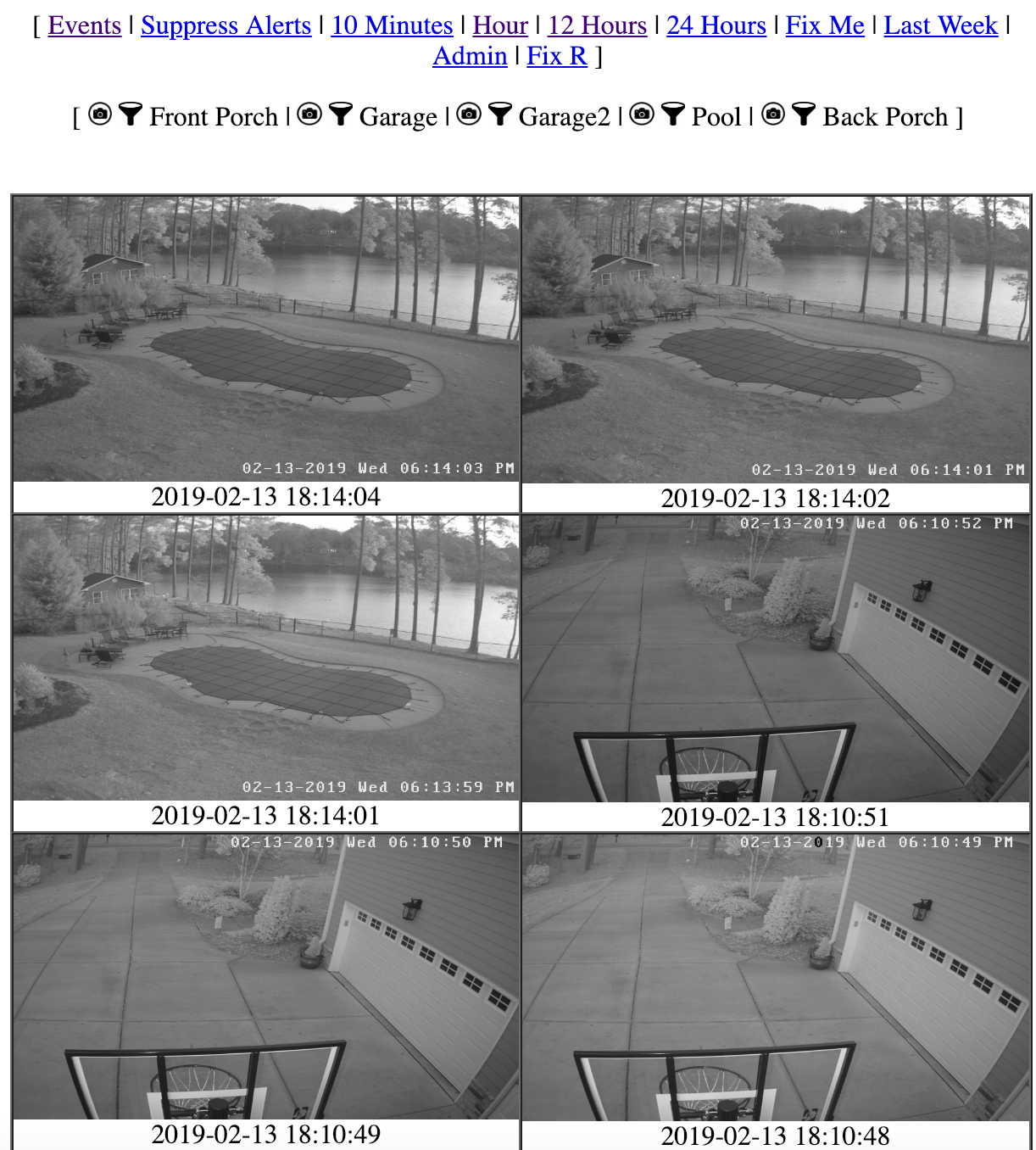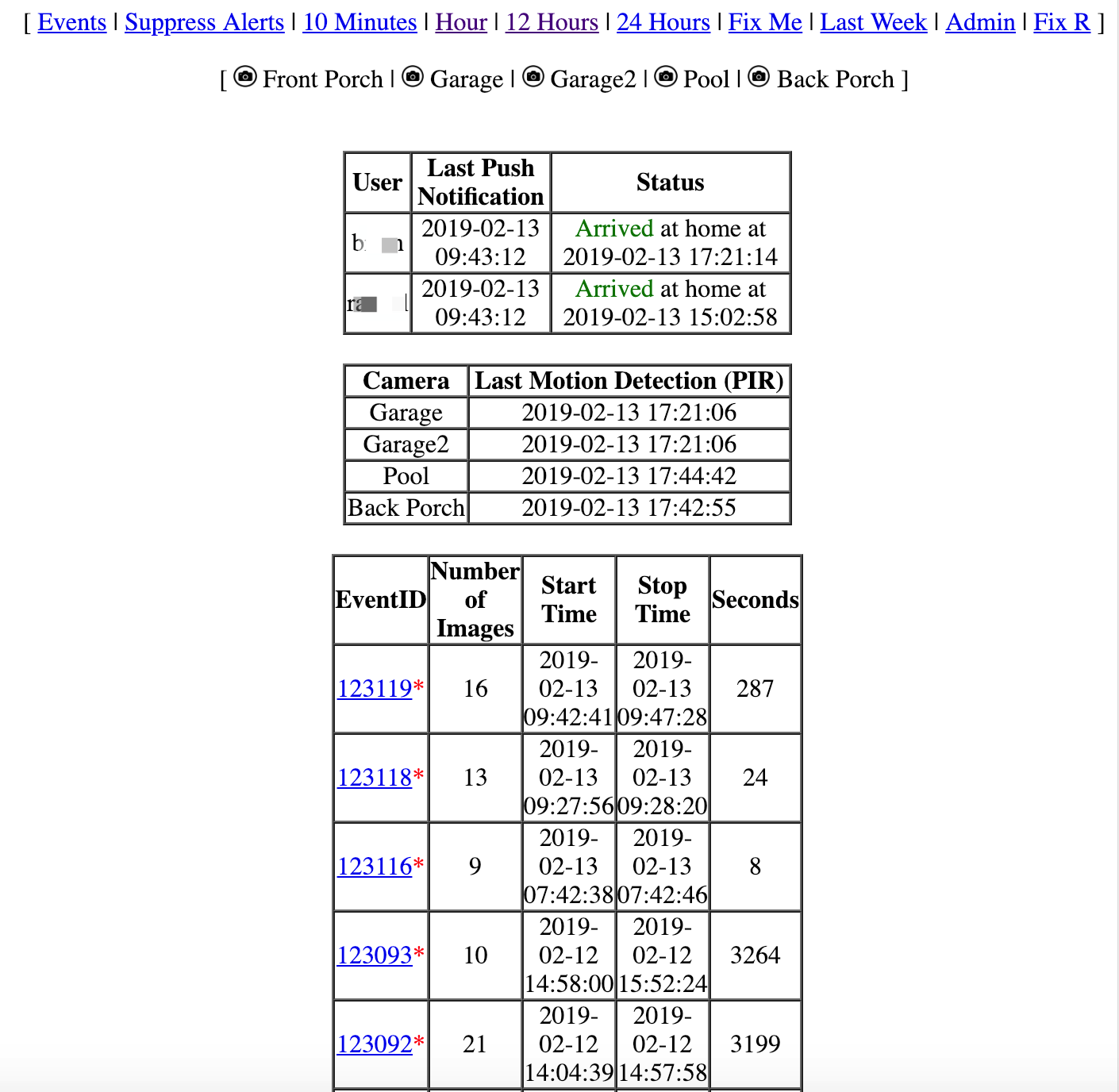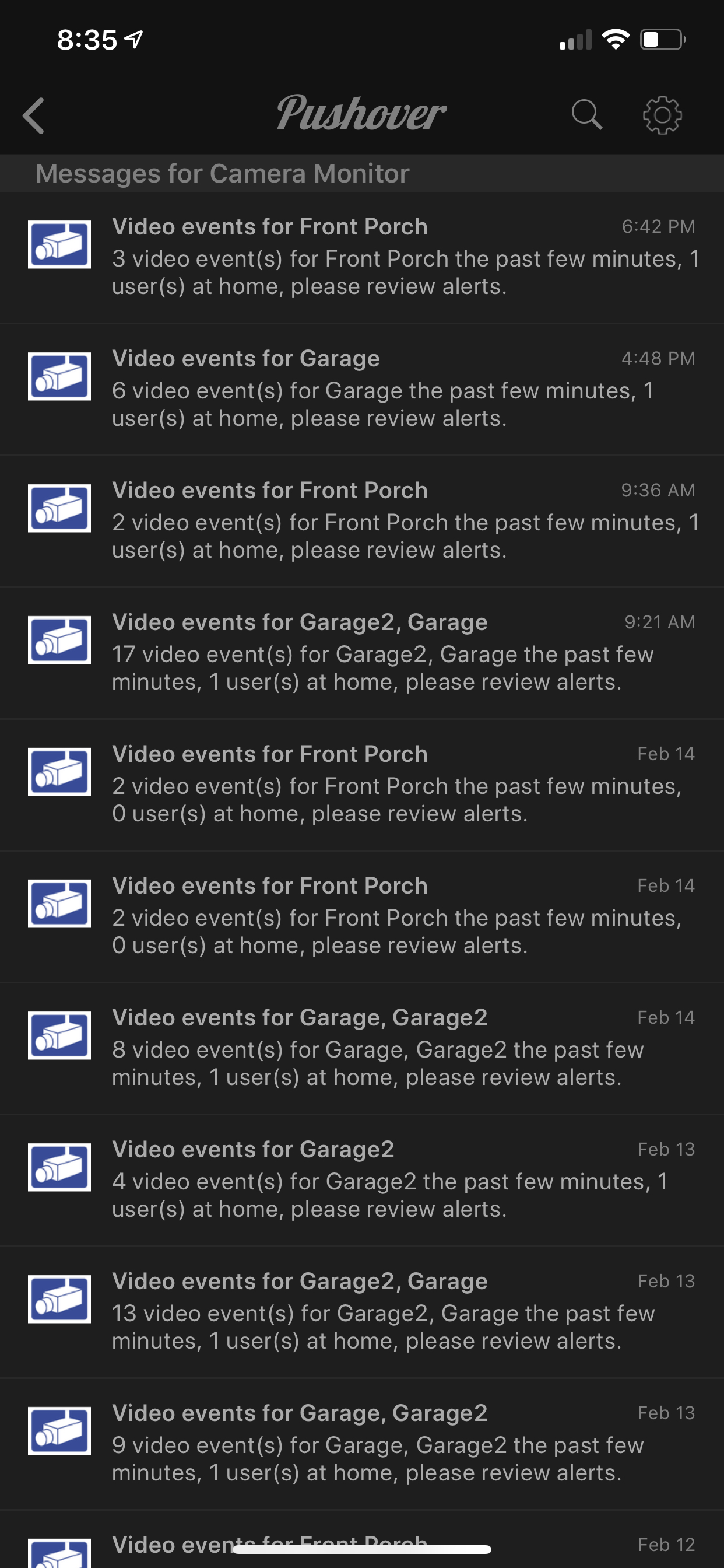This set of scripts allows users the ability to read a directory full of images (i.e. images FTP'ed by your camera), send a notification to your mobile device (via [Pushover](https://pushover.net/)), and allow you to view the images. This script also allows you to specify times to exclude notifications and will exclude notifications around sunrise/sunset times. It includes rudimentry authentication so you can limit who can access your notifications as well as the ability to suppress notifications for some period of time from your phone (i.e. in case you're expecting lots of movement for a particular period). I currently use these with my Hikvision and Amcrest cameras since their built-in motion detection + built NVR capabilities in writing to SMB shares. This allows me to do all of my monitoring (Web server, MySQL, VSFTP, SMB, Exim) on a Raspberry Pi with an external drive.
- Linux system (or Raspberry Pi)
- Pushover account - You will also need to register an application and you can use my logo (https://pushover.net/icons/TKeuSZYBwATtanz.png). There is a free trial period available so you can see if you like the app; it's awesome and definately money well spent.
- Apache (or webserver you know how to configure) that is Internet accessible (or can be opened to the Internet).
- MySQL (and PHPMyAdmin if you aren't comfortable updating/adding cameras/users via command-line).
- FTP Server - This script expects each camera to store images in a sub-directory.
- An IP camera that supports FTP of images when motion is triggered and optionally a URL to display a real-time snapshot and also sending of email when an event happens - see below in calling the procmail script)
- Some method of calling the alert script (cronjob or via e-mail based procmail trigger)
- Perl (and these modules: File::Basename File::Find File::stat Date::Manip Time::localtime LWP::UserAgent Astro::Sunrise Data::Dumper DBI)
- Optional iOS App GeoHopper helps identify if the user is home or away
- Optional PIR (Passive Infared) sensor support via Hubitat/SmartThings virtually elminate false postives from the cameras.
I recommend installing cpanminus and installing the Perl modules that way, or you can intall them via your distro packaging system.
sudo apt-get install curl curl -L http://cpanmin.us | perl - --sudo App::cpanminus
Then install the modules..
sudo cpanm File::Basename File::Find File::stat Date::Manip Time::localtime LWP::UserAgent Astro::Sunrise Data::Dumper DBI
NOTE: If you're running a previous version (before 2/2019), you'll need to blow away your database and start over. I added eventID to the images table and pirName and pirTime to the cameras table. If you can figure this out without blowing away your db, mazeltov!
- Install Perl modules.
- Configure your webserver. For Apache, place cam.conf in /etc/apache2/sites-enabled and change the NVR location to the base location where directories are for each camera that your FTP server is writing to and NVR_WEB to be where you will store your PHP files. We'll copy these over later below. Restart Apache.
- Create MySQL user (assuming you're using root to create the account).
$ mysql -u root -p Enter Password: mysql> create database cam; mysql> create user cam; mysql> grant all on cam.\* to 'cam'@'localhost' identified by 'cam'; mysql> flush PRIVILEGES; mysql> quit
Then install the DB schema.
$ mysql -u cam -pcam cam < cam.sql
Now you can see an example of my data. ignoreHome and ignoreAway should be set to 0 unless you want to ignore/suppress events if someone is either Home or all users are Away. If you want to suppress events for the camera, then toggle these to 1 instead of 0. These variable rely on the GeoHopper dependancy.
mysql> select * from cameras; +-----+-------------+---------+---------------------------------------------------------------------+-----------------+------------+----------------------+-------------+-------------+ | cid | location | enabled | snapshot_url | ignore_ranges | ignoreHome | ignoreAway | pirName | pirTime | isAmcrest | +-----+-------------+---------+---------------------------------------------------------------------+-----------------+------------+------------+---------+-------------+-------------+ | 1 | Front Porch | 1 | http://user:[email protected]/Streaming/channels/1/picture | | 0 | 0 | | | 0 | | 2 | Garage | 1 | http://user:[email protected]/Streaming/channels/1/picture | 22-23,3:30-4:30 | 0 | 0 | | | 0 | +-----+-------------+---------+---------------------------------------------------------------------+-----------------+------------+------------+---------+-------------ا-------------+ mysql> select * from users; +-----+--------+-----------------+---------+-------+------+--------------------------------+--------------------------------+---------------------+--------+---------------------+ | uid | user | authkey | enabled | admin | week | pushoverApp | pushoverKey | lastNotify | isHome | homeTime | +-----+--------+-----------------+---------+-------+------+--------------------------------+--------------------------------+---------------------+--------+---------------------+ | 1 | admin | AAAAABBBAAAA | 1 | 1 | 1 | pushoverAppIDHere | pushoverAPIKeyHere | 2015-03-17 21:24:47 | 1 | 2015-03-17 17:10:51 | | 2 | user | BBBBAAAABBB | 1 | 0 | 0 | pushoverAppIDHere | pushoverAPIKeyHere | 2015-03-17 21:24:48 | 1 | 2015-03-17 14:55:54 | +-----+--------+-----------------+---------+-------+------+--------------------------------+--------------------------------+---------------------+--------+---------------------+
- Create your users and cameras. Note the the cron script will convert underscores (_) to spaces for location names, so your FTP directory should be "Front_Porch", but in the database, it should be "Front Porch". If you don't have a snapshot URL, then you can leave it blank. Ignore ranges can be blank too if you don't want to suppress any notifications (other than the default sunrise/sunset). The first column is auto-increment, so leave that empty like below). The week column enables the use of seeing all images for a whole week. This will kill your cellular data plan so you might not want to enable it for everyone. User AUTHKEY should be only numbers and letters to simplify things. It's not like you're protecting fort knox. This is also why I'm leaving the authkey in clear text as a GET. If you don't like it, send me a git pull. Also you have optional pirName and pirTime fields; these are updated from zwave/zigbee PIR sensors connected (theoretically) near your cameras reporting to Hubitat/Smartthings. This helps you eliminate false positives with a motion sensing camera by adding passive infared to the mix. For more info on those, look at the commments in hubitat.php. If you have multiple cameras in a single location, you can use one PIR sensor by giving them the same name (GarageSensor) if you have 2 cameras by the garage + 1 PIR sensor.
$ mysql -u cam -pcam
mysql> use cam;
mysql> insert into cameras VALUES("","Front Porch","1","http://user:[email protected]/Streaming/channels/1/picture","",0,0,"","",0);
mysql> insert into cameras VALUES("","Back Porch","1","http://user:[email protected]/Streaming/channels/1/picture","17-18,4:30-5:30",0,0,"","", 0);
mysql> insert into users VALUES("","user1","8675309","1","0","YOUR_PUSHOVER_APP_ID_HERE","YOUR_PUSHOVER_API_KEY_HERE","",0,"");
mysql> insert into users VALUES("","user2","C3PO","1","1","YOUR_PUSHOVER_APP_ID_HERE","YOUR_PUSHOVER_API_KEY_HERE","",0,"");
mysql> quit
- Copy config.php, index.php and image.php to the NVR_WEB location you configred in your Apache cam.conf. Edit config.php and set the webdir to be the Alias location where the images will be surfaced from (i.e. where your FTP server is writing files). Set ip_net to be a regex to match your local IP network if you want to bypass auth from that network. If you don't want to bypass auth on your local net, set this to be /^256.256.256.\d+$/.
- Edit nvr_alert.pl and modify/point to nvr_alert.cfg do the following:
- Configure your lat and long to correctly configure sunrise/sunset times. (maps.google.com) can help you if you look for your address then get the lat/long from the URL.
- Set loc to be the same location you configured as the NVR location in the cam.conf for Apache. This is the same directory that your FTP server is writing the images. This location should have sub-folders in it so each camera has their own directory with images in it.
- false_mins should contain the number of minutes above and below the sunrise/sunset that you want to use as a buffer. 20 seems to work good. Note, even if you're not notified of these items they will still show on the web. Also, you can uncomment and update a section of code in nvr_alert.pl if you want to debug suppressed alerts.
- days_to_keep is how many days worth of images you wish to keep. This will purge images from the database and file system older than X days. Set to 0 if you don't want it to remove any files. Your user that runs this job needs to have permissions to remove files from this location.
- url is the location where your index.php file will be served up from on the Internet.
- max_notify_interval is the minimum number of minutes inbetween nofications. This is mainly for if the job is run by an external script (such as procmail or snmptrap). If you're running this from cron, just set this to the same number of minutes the cronjob is run as.
- geohopper options should be self explanitory. You need to install the iOS app, create a Web Service item that points to your url/geohopper.php?auth=YOURAUTHID. Next, create a location called "Home", then link the Web Service entry to your "Home" location.
- database info should match config.php and the info you used to create your database and user from the initial steps.
- Make sure you can get to index.php without any errors. You can always uncomment out the first few lines of index.php to enable debugging if you are having issues.
- Setup a cronjob for nvr_alert.pl to run every 5 minutes. Make sure your max_notify_interval is set to 5.
\*/5 \* \* \* \* /mnt/storage/NVR/bin/nvr_alert.pl
- If you're using optional zwave/zigbee PIR sensors, make sure you configure them + setup the required app in Hubitat/SmartThings so that motion events make it back to your server.
- If you need to access snapshot images directly (i.e. image file vs. embedded in the GUI), you can use snapshot.php to do this. http://server/url/image.php?snapshot=2&auth=YOURAUTHID
Another option (which is what I do) is to setup your camera to email your Raspberry Pi/Linux box, then process those messages with procmail and have procmail trigger nvr_alert.pl. If you choose to go that route, you can use the nvr_procmail.sh script to call nvr_alert.pl. It will keep more than 1 instance from running at a time and give 60 seconds for images from an "event" to roll in. This method also helps when using Geohopper since it essentially gives the system 60 seconds for you to "leave" or "arrive" at your Home before calling nvr_alert.pl, thus your Geohopper suppression will work better. You'll have to setup a user on your Linux machine, configure a Mail daemon to receive mail, make sure procmail is installed and enabled for your mailer, and then setup a .procmailrc (see comments in nvr_procmail.sh for more info).
- Make sure your Apache user can access the files your FTP user writes.
- Uncomment the debug lines in index.php if "things aren't working".
- Drop a .jpg file into your a Test sub-directory under your FTP folder and run nvr_alert.pl by hand from the command line.
- Directory layout should look similar to this:
- FTP Directory
/mnt/storage/NVR <-- Base FTP directory /Camera <-- Sub-directory for Camera 1 /Camera_2 <-- Sub-directory for Camera 2- Web Directory
/mnt/storage/NVR_WEB <-- Base Web Directory /index.php <-- PHP Scripts /config.php /image.php - Check your log.
- Contact me for help (see below). It's alot harder to explain and document software for someone else than it is to just do it for yourself, so I'm sure I left something out.
Bug me on Twitter at @brianwilson or email me here.
There is also a thread at IPCamTalk where you can find out more info/receive support.


